-
Posts
6,486 -
Joined
-
Last visited
-
Days Won
9
Content Type
Profiles
Forums
Blogs
Gallery
Events
Store
Posts posted by Brian Wolfe
-
-
How about..."Would you please sign my photo?" :-)
Good point, Chris.
As obvious as that sounds, if he is still living there and I was granted an interview, that would be the one thing I would have probably forgotten to ask for.

Regards
Brian
0 -
Hi,
I piced up this medal bar from the Dublin fair today. Any toughts, etc. Probably I will let it go one moment but its just looked great and the price was fine too
 .
.
Nice group. Is it named?
Regards
Brian
0 -
Many thanks, Rick.
Regards
Brian
0 -
Hello Everyone,
I picked up this photo of the U 889, a Type IXC U-boat, at an outdoor antiques show and sale this morning. It was a long morning in the rain and just as we were about to leave I spotted this actual photo of a submarine and I figured I was going to bring something home even if it was an unresearchable photo from WW II. When I got home I saw that it had the identity number U889 on the tower. Here's some of what I found out this afternoon.
From www.hazegray.org
"At the end of The Second World War, a couple of German U-boats surrendered to the Royal Canadian Navy, U 190 and U 889 on May 12th and 13th, 1945, respectively. These large IXC/40 type submarines were commissiooned into the RCN and used for testing and evaluation. Early in 1946, U 889 was turned over the the United States Navy for further testing, and a year later she was sunk in torpedo tests off the coast of New England. The U 190 stayed with the RCN a bit longer, and was paid off in July of 1947."
Another (unidentified) source has this to say (note the different date)
"On May 10, 1945 U 889 became the first U-boat in the Western Atlantic to surrender when she gave herself up [12 miles] off Shelburne, N.S. [Nova Scotia], to HMC Ships OSHAWA and ROCKCLIFF (Algerines) and DUNVEGAN and SASKATOON (corvettes). In January 1946 she was turned over to the United States Navy."
A short history of the U 889 comes from www.submariners.co.uk
"U-889 was a type IXC U-boat which spent some months in Canadian hands after the German surrender in 1945, before being handed over to the United States Navy the following year. She was examined in minute detail and the results have survived, giving a unique account of the layout and equipment of a U-boat.
The U-889 was built by Deschimag or AG Weser Bremenin 1944 and commissioned on 8th August 1944.
She left Kiel on the 28th March 1945 and arrived at Horten two days later. On the 2nd April she sailed west with orders to attack shipping in the approaches to Halifax, but on the 10th May she was still 60 miles south of Cape Race when Admiral Donitz broadcast the order to surrender.
After surfacing she was sighted by an aircraft of the no. 10 Squadron RCAF [sunderland flying boats] and handed over to an Escort group who took her into Shelburne, Nova Scotia."
Following is a list of the crew of the U 889,
Name Rank
Braeucker Fredrick KpLt. 01.07.44
Eve Willi OLt.ing
Gamhofer
Haas Hans OStrm.
Jager Lt.z.S
Kaluscha Max Fk.
Lochert Werner Lt.z.S
Lutzmann Gunter- Fk
Werner
Mursinsky Arthur KpLt
Remmers Hein OStrm
Sass Walter Lt.z.S
Notes:
Gunter-Werner Lutzmann lives in Stratford, Ontario, which is only 20 km from me, perhaps a phone call and an in-person interview might be interesting. But what to ask?
Regarding the ranks above, I can't tell you what the abbreviations stand for, sorry. More research ahead.
So my last minute purchase turned out to be very researchable and a piece of WW II Canadian Naval history. Finding these gems is like fishing, you never know when you will "get a bite" so keep your line in the water until the very last second.
Cheers

Brian
 0
0 -
The School Bus:

Hi Lorenzo,
So that answers the question regarding the black device on the front.
Not meaning to give away secrets but the black device is lowered when the bus is dropping kids off so they won't get out of the driver's sight while crossing in front of the bus!

Cheers

Brian
0 -
With 30 years separation, I don't suppose there'll be many who'll be eligible for both, but it's still a shame they didn't make more of a differentiation. Also, the black stripe really gets lost on that "Pakistan" green ribbon. Thanks for posting - now, how to get one?
Hugh
You're right about the black stripe. In fact I originally though one of the dark green stripes was dark blue but under better light I found it to be green. I've always thought that the 1971 War Medal ribbon strips represented the Army, Navy and Air Force but on the Escalation Medal instead of dark blue there is a black stripe. More than a little confusing.
Regards
Brian
0 -
Interesting. Any details on the Gazette of Pakistan notification?
No details from the dealer in Islamabad about the medal but at least he came through with a ribbon. The lack of information is very frustrating.
Regards
Brian
0 -
Here are the ribbons of the 1971 War medal on the bottom and the Escalation Medal on top. I have separated the ribbons with some white paper to help highlight the differences as much as I can.
The 1971 War Medal has three stripes of light blue, dark blue and red on a dark green field.
The Escalation Medal also has three stipes which are light blue, red and black separated by dark green stripes on a dark green field.
The two ribbons are very close in appearance.
Thanks for looking at my post.
Regards
Brian
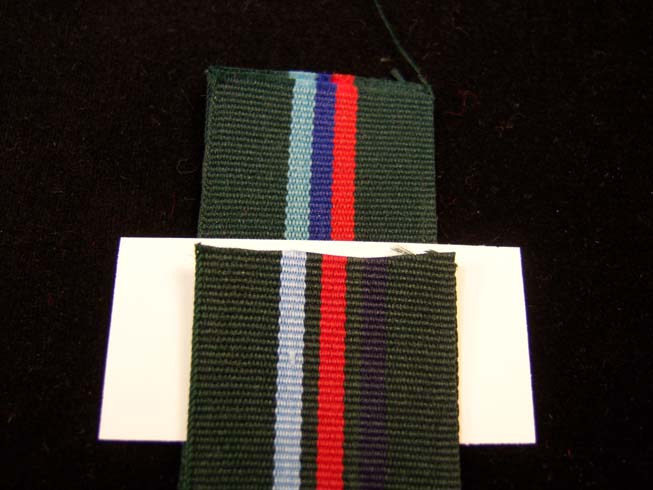 0
0 -
Here is the obverse.
 0
0 -
Hello Everyone,
During 2001/02 there was a build up of arms along the India Pakistan border that looked very much like both sides were perparing for yet another conflict. India issued a medal called the Op Parakram which was awarded for the same "escalation" by their troops. Please check the internet for a history of this near-conflict if you are interested. I have made several friends in both India and Pakistan and rather than making a political blunder and insulting any of them I will refrain from giving any more history on the issue. I am not known for my tact.

The Tamgha-i-Ishtiqlal 2001/02 looks a lot like the Pakistan Independence medal at first glance with the country's flag on the obverse. The reverse is the same as the 1385 Tamgha-i-Jang/1965 War Medal and the Tamgha-i-Jang/1971 War Medal obverses other than the wording "ESCALATION 2001-02" printed below the symbols of the different armed forces.
The ribbon is also much like the 1971 War Medal but I won't go into that detail other than showing the differences in my last photo.
Regards
Brian
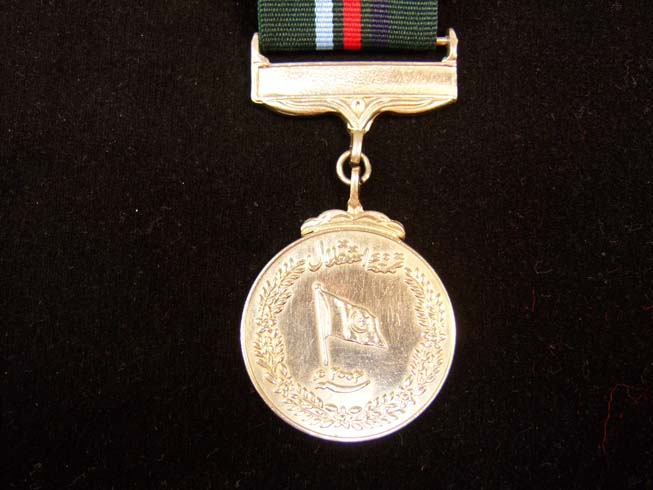 0
0 -
Hi Brian,
I seem to recall that the 'P' stands for purged,as in the set was purged of gas/water etc.
I think this was done as many of these sets saw post WW2 use in Korea.
I had a set that was stamped 'W' which I think meant they had been tested for watertightness.
Hope this helps?
Kind regards,
Andy
Thanks Andy, that is a great help.
I like to know as much as possible about the items in my collection.
 Cheers
CheersBrian
0 -
This is the back of my mount.
Not a lot to look at unless you like red.

Regards
Brian
 0
0 -
Here is a group that I just completed court mounting. The Raksha Medal was missing so I have replaced it with an unnamed example. This group shows a good progression through the ranks by a member of the Sikh Regiment.
The group is named as follows,
Samar Seva Star 3344332 NK. SARWAN SINGH (no regimental naming)
Poorvi Star 3344332 HAV. SARWAN SINGH, SIKH R.
Raksha Medal (unnamed replacement)
Sangram Medal 3344323 HAV. S. SINGH, SIKH R. (note the numbering error)
20 Year L.S. 3344332 CQMH SARWAN SINGH, SIKH R.
9 Year L.S. 3344332 HAV. SARWAN SINGH, SIKH R.
Ranking note:
NK. = Naik (equivalent to a Corporal)
HAV. = Havildar (equivalent to a Sergeant)
CQMH. = Company Quarter Master Havildar (Equivalent to a Company Quarter Master Sergeant)
Thanks for looking.
Regards
Brian
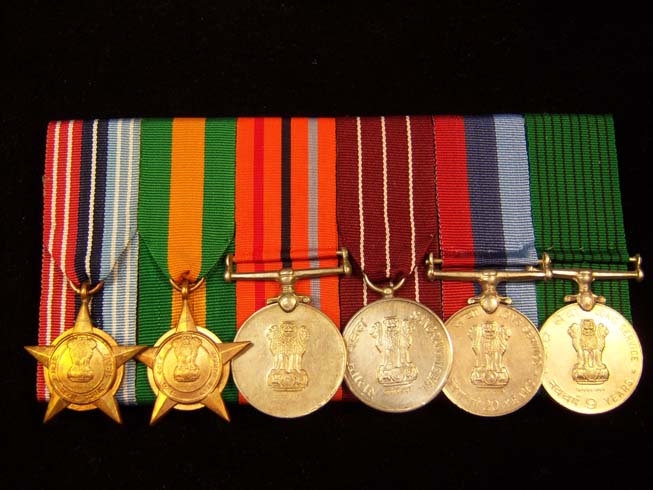 0
0 -
Here's a better photo of the regimental name. My wife is partial to the Midlands area of Ontario so adding this medal to the collection made us both quite pleased.
Thanks for viewing my post.
Regards
Brian
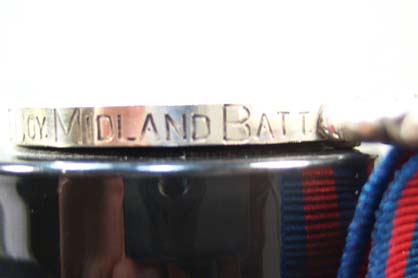 0
0 -
More of the engraving.
Sorry about the focus.
 0
0 -
Following are some photos of the engraving.
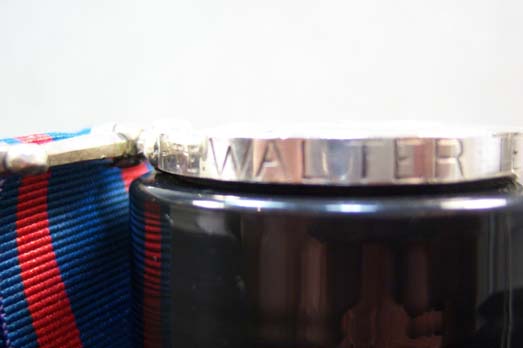 0
0 -
Here is the reverse.
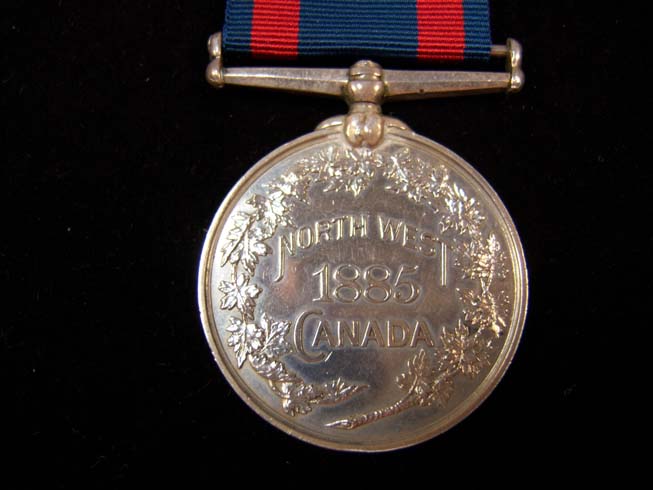 0
0 -
Hello Everyone,
Here is the 10th Wedding Anniversary gift my wife bought for me. I have wanted a North West Canada Medal for a long time but always found other places for my cash especially considering what these are worth. We were on vacation when this was delivered and to make it extra special it actually arrived 6 days late for the anniversary but on my birthday! My birthday gift is still in the mail, coming from India.
My wife is a fan of Victorian medals and I consider that area of the collection as her's but it is still the greatest anniversary gift I've ever recieved. Some day I'll post her section of the collection.
Just a little history of what this medal was awarded for comes from the Royal Canadian Regiment (RCR) Museum and involves the Northwest Rebellion of 1885.
"Once referred to as the "Riel Rebelllion" the Northwest Rebellion, marked the only war in history fought entirely by Canadian troops. The rebellion pitted the English ruling establishment against the French-speaking Metis and Planes Indians tribes of Saskatchewan. Drawn together by the frustration of dealing with an unresponsive government, the Metis and Plains Indian leaders proclaimed their own "Governing Council of the Province of Sasketchewan" at Batoche, 18 March 1885. The ability to move troops across vast distances using rail travel, drastically reducing time spent "marching" to the battle destination, was one of the keys to the downfall of the rebellion.
Louis Riel surrendered to Goivernment Forces that included "C" Company of the Infantry School Corps (precursor the The Royal Canadian Regiment) on 12 May 1885 at Batoche. The rebellion ended on the 2nd of July1885 with the surrender of the Cree leader, Chief Big Bear."
In a way you could say this was a mini civil war, but I won't go any rather with that notion here. I remember as a kid being taught that Luois Riel was a traitor to his nation, then yaers later he became a folk hero. Perhaps in time he will be seen as a National hero, but here I go slipping into a political debate which is not my intent.
The medal I have is without a bar (Saskatchewan) which is not uncommon. It is named to,
PTE.WALTER TEMPEST E. Coy. MIDLAND BATT. research in the National Archives has found his regimental number to be 269.
It is named in large block letters and I am thinking Pte. Tempest had the engraving done after the medal was awarded as is also not uncommon.
Other statistics regarding this medal are as follows.
5,650 medals issued.
16 to British Officers
1,753 with the Saskatchewan Bar
920 to the R.C.M.P.
(leaving 2,961 issued without bars to other ranks)
There were 363 men in the Midlands Batt.
I hope you like my anniversary gift.
Cheers

Brian
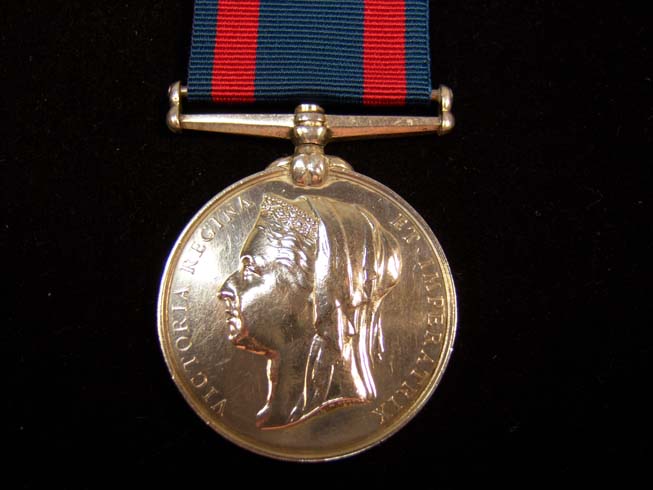 0
0 -
This is the view of the eye piece end of the binoculars. There is a broad arrow on the right hand piece but you can't see it in this photo. It is just below the red "P". Would anyone know what the red "P" stands for. Could it be the inspection mark indicating that the set Passed inspection? The company logo NL can be seen and I would like to know the marker's name if anyone can provide that information. The eye pieces are focused independently unlike civilian types that adjusted by a single "dialer" between the eye pieces. These you set for each eye them check the numbers on the side of the eye piece and then if they are ever changed you can return them to your own settings quickly.
You can see the electrodes clearly in this photo. How were these used? What did you hook them up to? Was there a "station" that they were stored in like the rechargeable radios we used to use? Would these binoculars be used by infantry, artillery or navy or were they common to all of the services?
Thanks for looking at my new addition to the collection.
I hope you liked them.
Cheers

Brian
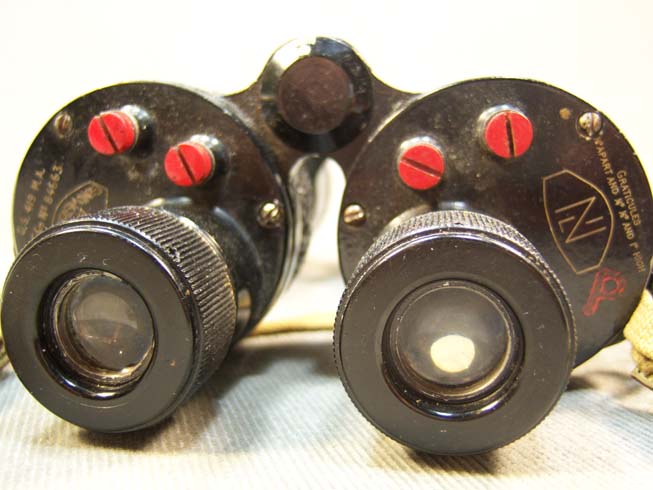 0
0 -
This is a view of one of the eye pieces area.
You can see the government broad arrow marking.
Brian
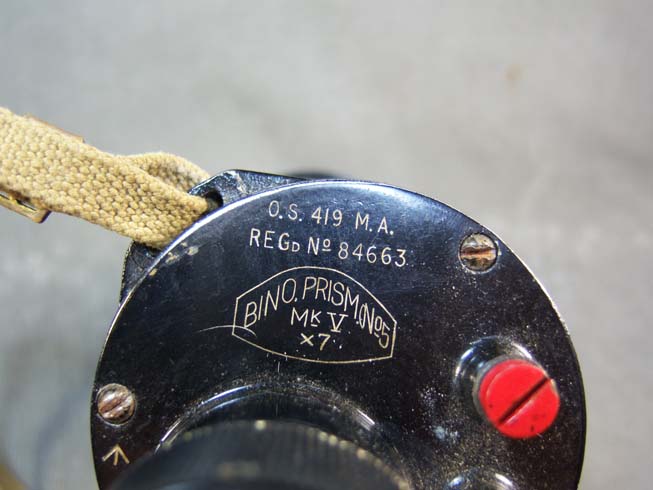 0
0 -
This is the top of the leather case.
You can see the stitching "problems" I mentioned . I've going to leave it alone as any attempt to repair it may make it worse.
The lettering stamped into the top reads,
BINO. PRISM. NO 5
CASE MK 1 O.S. 997
B.L.G.
1944
Any information on the markings such as what B.L.G. stands for would be appreciated.
Brian
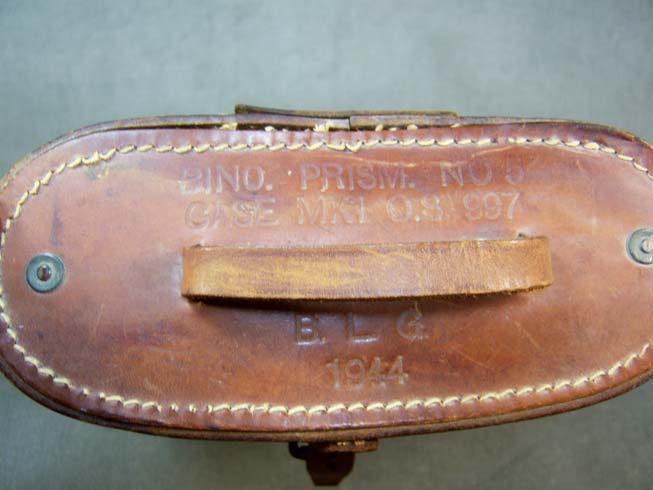 0
0 -
Hello Everyone,
Last week I was reviewing some work to be done on one of our lakes with a contractor friend on mine. I have one of those jobs were I get to spend most of my time looking after cottagers around two lakes owned by a Conservation Authority. The only job I've ever had where I can sign out a canoe in the summer or survival suit or snow shoes in the winter. Yep, it's the job of life-time.
Anyway we got talking about how my equipment had been stolen a few week earlier and then returned by the police. With the equipment was a pair of binoculars that I had replaced not knowing I'd ever see my gear again. The contractor said they looked like a good pair and said he'd have to get a new pair for his boat some day. So, since it was my personal equipment, I gave him one pair. Hard to use two pairs of binoculars.
A few days later we were again reviewing some work to be done and he handed me this pair of binoculars. He told me they had belonged to his father and he wanted me to have them. "Consider it a trade" he said. Man, you could have knocked me over with a feather!

The case is intact with just a little stitching problems on the top around the leather hinge area, nothing serious. The binoculars are in great shape and have the government broad arrow markings. There is a horizontal line inscribed in one lens with a series of verticle lines running upwards from it. Research shows that at 1000 metres the verticle lines indicate spacings of 5 metres. I would guess this would apply to yards as well at least that seems to make sense to me. What are the opinions of the membership on the spacing?
There are two red screws on each eye piece. I have read that these are electrical contacts used for internal drying or demisting. Can anyone expand on this?
I've wanted a pair of military binoculars for some time now and I hope you like them as well.
Cheers

Brian
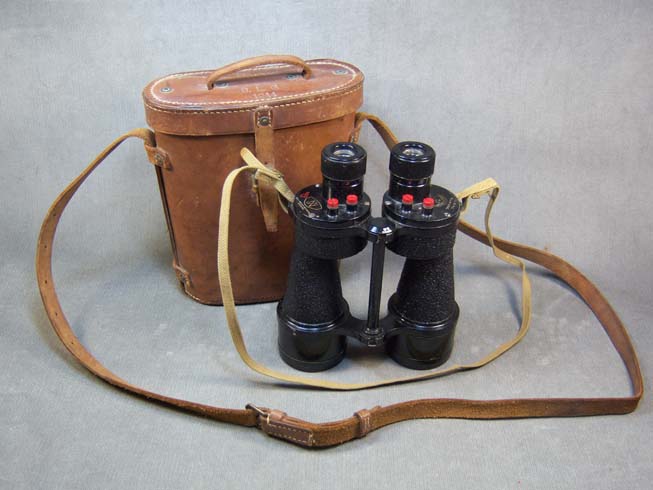 0
0 -
This is the socket.
The blade and socket are all made from one piece of steel. You can see the design on the socket is simply rings filed around the socket.
The workmanship is actually quite good and you barely feel any hammer marks on the blade and the tapper from the socket area to the blade is very well done.
I hope someone can help me with this new addition.
Thanks again
Brian
 0
0 -
Here is a photo of some of the design on the blade.
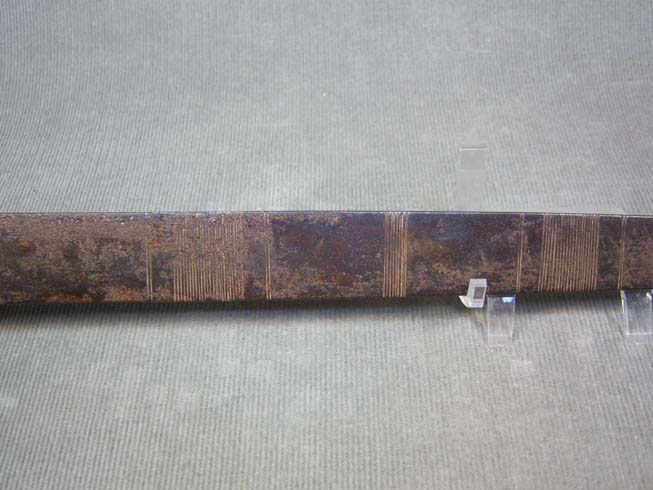 0
0




WW I British 105mm Howitzer
in Firearms & Ordnance
Posted
I'm adding this photo to this post even though it is a WW I German 106mm howitzer and not British because I though it would be a good example of "the other side's" artillery piece of nearly the same calibre.
Too bad the sign on the piece is not clearer but I've tried several methods of magnification with limited results.
The sign on the trench howitzer is impossible to read.
Anyway I like the photo and here it is.
Regards
Brian